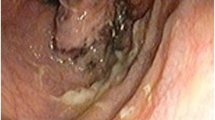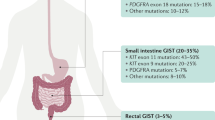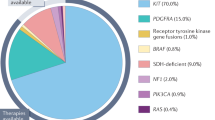Abstract
Recent advances in our understanding of the genetic mutations associated with melanoma have led to the classification of distinct melanoma subtypes. A number of reports have consistently demonstrated that mucosal and acral melanomas more commonly harbor KIT-activating mutations than do other subtypes. Success in treating gastrointestinal stromal tumors with imatinib has led to speculation that KIT-mutated melanoma might also be effectively managed using this approach. A 78-year-old woman presented with a 4-month history of rectal bleeding. A colonoscopy revealed a black polypoid mass, 30 mm in diameter, originating near the dentate line, and a biopsy revealed malignant melanoma. Computed tomography showed multiple liver and lung metastases. A KIT mutation analysis showed the L576P mutation in exon 11. The patient did not want to undergo chemotherapy including a tyrosine-kinase inhibitor, so palliative radiotherapy for rectal symptoms was performed, but the patient died 4 months later due to disease progression. We describe the first case of anorectal melanoma with a KIT-activating mutation in Japan and summarize findings from the literature regarding the efficacy of KIT kinase inhibitors on this melanoma subtype.




Similar content being viewed by others
References
Goldman S, Glimelius B, Påhlman L (1990) Anorectal malignant melanoma in Sweden. Report of 49 patients. Dis Colon Rectum 33:874–877
DeMatos P, Tyler DS, Seigler HF (1998) Malignant melanoma of the mucous membranes: a review of 119 cases. Ann Surg Oncol 5:733–742
Quan SH (1992) Anal cancers. Squamous and melanoma. Cancer 70:1384–1389
Curtin JA, Busam K, Pinkel D et al (2006) Somatic activation of KIT in distinct subtypes of melanoma. J Clin Oncol 24:4340–4346
Fecher LA, Cummings SD, Keefe MJ et al (2007) Toward a molecular classification of melanoma. J Clin Oncol 25:1606–1620
Antonescu CR, Busam KJ, Francone TD et al (2007) L576P KIT mutation in anal melanomas correlates with KIT protein expression and is sensitive to specific kinase inhibition. Int J Cancer 121:257–264
Beadling C, Jacobson-Dunlop E, Hodi FS et al (2008) KIT gene mutations and copy number in melanoma subtypes. Clin Cancer Res 14:6821–6828
Satzger I, Schaefer T, Kuettler U et al (2008) Analysis of c-KIT expression and KIT gene mutation in human mucosal melanomas. Br J Cancer 99:2065–2069
Ashida A, Takata M, Murata H et al (2009) Pathological activation of KIT in metastatic tumors of acral and mucosal melanomas. Int J Cancer 124:862–868
Hirota S, Isozaki K, Moriyama Y et al (1998) Gain-of-function mutations of c-kit in human gastrointestinal stromal tumors. Science 279:577–580
Demetri GD, von Mehren M, Blanke CD et al (2002) Efficacy and safety of imatinib mesylate in advanced gastrointestinal stromal tumors. N Engl J Med 34:472–480
Verweij J, Casali PG, Zalcberg J et al (2004) Progression-free survival in gastrointestinal stromal tumours with high-dose imatinib: randomised trial. Lancet 364:1127–1134
Brady MS, Kavolius JP, Quan SH (1995) Anorectal melanoma. A 64-year experience at Memorial Sloan-Kettering Cancer Center. Dis Colon Rectum 38:146–151
Thibault C, Sagar P, Nivatvongs S et al (1997) Anorectal melanoma—an incurable disease? Dis Colon Rectum 40:661–668
Ishizone S, Koide N, Karasawa F et al (2008) Surgical treatment for anorectal malignant melanoma: report of five cases and review of 79 Japanese cases. Int J Colorectal Dis 23:1257–1262
Kitamura Y, Hirota S, Nishida T (2001) A loss-of-function mutation of c-kit results in depletion of mast cells and interstitial cells of Cajal, while its gain-of-function mutation results in their oncogenesis. Mutat Res 477:165–171
Kitamura Y, Hirotab S (2004) Kit as a human oncogenic tyrosine kinase. Cell Mol Life Sci 61:2924–2931
Rivera RS, Nagatsuka H, Gunduz M et al (2008) C-kit protein expression correlated with activating mutations in KIT gene in oral mucosal melanoma. Virchows Arch 452:27–32
Carvajal RD, Chapman PB, Wolchok JD et al (2009) A phase II study of imatinib mesylate (IM) for patients with advanced melanoma harboring somatic alterations of KIT. J Clin Oncol 27(15s):abstr 9001
Torres-Cabala CA, Wang WL, Trent J et al (2009) Correlation between KIT expression and KIT mutation in melanoma: a study of 173 cases with emphasis on the acral-lentiginous/mucosal type. Mod Pathol 22:1446–1456
Handolias D, Hamilton AL, Salemi R et al (2010) Clinical responses observed with imatinib or sorafenib in melanoma patients expressing mutations in KIT. Br J Cancer 102:1219–1223
Terada T (2010) Low incidence of KIT gene mutations and no PDGFRA gene mutations in primary cutaneous melanoma: an immunohistochemical and molecular genetic study of Japanese cases. Int J Clin Oncol 15(5):453–456
Yang J, Du X, Lazar AJ et al (2008) Genetic aberrations of gastrointestinal stromal tumors. Cancer 113:1532–1543
Ugurel S, Hildenbrand R, Zimpfer A et al (2005) Lack of clinical efficacy of imatinib in metastatic melanoma. Br J Cancer 92:1398–1405
Wyman K, Atkins MB, Prieto V et al (2006) Multicenter Phase II trial of high-dose imatinib mesylate in metastatic melanoma: significant toxicity with no clinical efficacy. Cancer 106:2005–2011
Kim KB, Eton O, Davis DW et al (2008) Phase II trial of imatinib mesylate in patients with metastatic melanoma. Br J Cancer 99:734–740
Hodi FS, Friedlander P, Corless CL et al (2008) Major response to imatinib mesylate in KIT-mutated melanoma. J Clin Oncol 26:2046–2051
Lutzky J, Bauer J, Bastian BC (2008) Dose-dependent, complete response to imatinib of a metastatic mucosal melanoma with a K642E KIT mutation. Pigment Cell Melanoma Res 21:492–493
Quintás-Cardama A, Lazar AJ, Woodman SE et al (2008) Complete response of stage IV anal mucosal melanoma expressing KIT Val560Asp to the multikinase inhibitor sorafenib. Nat Clin Pract Oncol 5:737–740
Zhu Y, Si L, Kong Y et al (2009) Response to sunitinib in Chinese KIT-mutated metastatic mucosal melanoma. J Clin Oncol 27(Suppl):abstr e20017
Kluger HM, Dudek A, McCann C et al (2009) A phase II trial of dasatinib in advanced melanoma. J Clin Oncol 27(15s):abstr 9010
Woodman SE, Trent JC, Stemke-Hale K et al (2009) Activity of dasatinib against L576P KIT mutant melanoma: molecular, cellular, and clinical correlates. Mol Cancer Ther 8:2079–2085
Terheyden P, Houben R, Pajouh P et al (2010) Response to imatinib mesylate depends on the presence of the V559A-mutated KIT oncogene. J Invest Dermatol 130:314–316
Satzger I, Küttler U, Völker B et al (2010) Anal mucosal melanoma with KIT-activating mutation and response to imatinib therapy—case report and review of the literature. Dermatology 220:77–81
Kato T, Takematsu H, Tomita Y et al (1987) Malignant melanoma of mucous membranes. A clinicopathologic study of 13 cases in Japanese patients. Arch Dermatol 123:216–220
Johnson DS, Yamane S, Morita S et al (2003) Malignant melanoma in non-Caucasians: experience from Hawaii. Surg Clin North Am 83:275–282
Ishihara K, Saida T, Otsuka F et al (2008) Statistical profiles of malignant melanoma and other skin cancers in Japan: 2007 update. Int J Clin Oncol 13:33–41
Conflict of interest
None of the authors has a conflict of interest in relation to the publication of this manuscript.
Author information
Authors and Affiliations
Corresponding author
About this article
Cite this article
Itoh, M., Goto, A., Wakasugi, H. et al. Anorectal melanoma with a KIT-activating mutation, which is a target for tyrosine kinase inhibitor. Int J Clin Oncol 16, 428–434 (2011). https://doi.org/10.1007/s10147-010-0139-5
Received:
Accepted:
Published:
Issue Date:
DOI: https://doi.org/10.1007/s10147-010-0139-5




